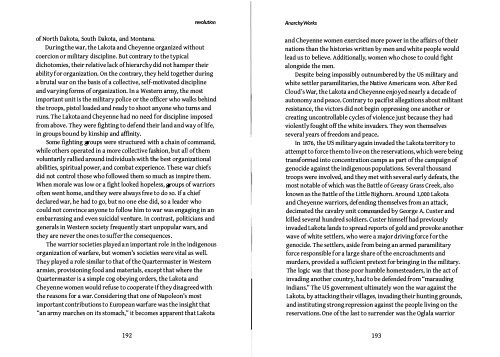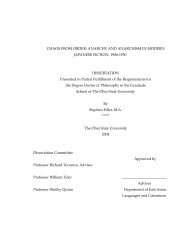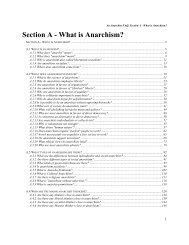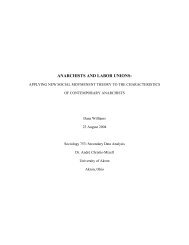Anarchy Works.pdf - Infoshop.org
Anarchy Works.pdf - Infoshop.org
Anarchy Works.pdf - Infoshop.org
You also want an ePaper? Increase the reach of your titles
YUMPU automatically turns print PDFs into web optimized ePapers that Google loves.
evolution<br />
<strong>Anarchy</strong> <strong>Works</strong><br />
of North Dakota, South Dakota, and Montana.<br />
During the war, the Lakota and Cheyenne <strong>org</strong>anized without<br />
coercion or military discipline. But contrary to the typical<br />
dichotomies, their relative lack of hierarchy did not hamper their<br />
ability for <strong>org</strong>anization. On the contrary, they held together during<br />
a brutal war on the basis of a collective, self-motivated discipline<br />
and varying forms of <strong>org</strong>anization. In a Western army, the most<br />
important unit is the military police or the officer who walks behind<br />
the troops, pistol loaded and ready to shoot anyone who turns and<br />
runs. The Lakota and Cheyenne had no need for discipline imposed<br />
from above. They were fighting to defend their land and way of life,<br />
in groups bound by kinship and affinity.<br />
Some fighting groups were structured with a chain of command,<br />
while others operated in a more collective fashion, but all of them<br />
voluntarily rallied around individuals with the best <strong>org</strong>anizational<br />
abilities, spiritual power, and combat experience. These war chiefs<br />
did not control those who followed them so much as inspire them.<br />
When morale was low or a fJght looked hopeless, groups of warriors<br />
often went home, and they were always free to do so. If a chief<br />
declared war, he had to go, but no one else did, so a leader who<br />
could not convince anyone to follow him to war was engaging in an<br />
embarrassing and even suicidal venture. In contrast, politicians and<br />
generals in Western society frequently start unpopular wars, and<br />
they are never the ones to suffer the consequences.<br />
The warrior societies played an important role in the indigenous<br />
<strong>org</strong>anization of warfare, but women's societies were vital as well.<br />
They played a role similar to that of the Quartermaster in Western<br />
armies, provisioning food and materials, except that where the<br />
Quartermaster is a simple cog obeying orders, the Lakota and<br />
Cheyenne women would refuse to cooperate if they disagreed with<br />
the reasons for a war. Considering that one of Napoleon's most<br />
important contributions to European warfare was the insight that<br />
"an army marches on its stomach," it becomes apparent that Lakota<br />
and Cheyenne women exercised more power in the affairs of their<br />
nations than the histories written by men and white people would<br />
lead us to believe. Additionally, women who chose to could fight<br />
alongside the men.<br />
Despite being impossibly outnumbered by the US military and<br />
white settler paramilitaries, the Native Americans won. After Red<br />
Cloud's War, the Lakota and Cheyenne enjoyed nearly a decade of<br />
autonomy and peace. Contrary to pacifist allegations about militant<br />
resistance, the victors did not begin oppressing one another or<br />
creating uncontrollable cycles of violence just because they had<br />
Violently fought off the white invaders. They won themselves<br />
several years of freedom and peace.<br />
In 1876, the us military again invaded the Lakota territory to<br />
attempt to force them to live on the reservations, which were being<br />
transformed into concentration camps as part of the campaign of<br />
genocide against the indigenous populations. Several thousand<br />
troops were involved, and they met with several early defeats, the<br />
most notable of which was the Battle of Greasy Grass creek, also<br />
known as the Battle of the Uttle Bighorn. Around 1,000 Lakota<br />
and Cheyenne warriors, defending themselves from an attack,<br />
decimated the cavalry unit commanded by Ge<strong>org</strong>e A. Custer and<br />
killed several hundred soldiers. Custer himself had previously<br />
invaded Lakota lands to spread reports of gold and provoke another<br />
wave of white settlers, who were a rn;;yor driving force for the<br />
genocide. The settlers, aside from being an armed paramilitary<br />
force responsible for a large share of the encroachments and<br />
murders, provided a sufficient pretext for bringing in the military.<br />
The logic was that those poor humble homesteaders, in the act of<br />
invading another country, had to be defended from "marauding<br />
Indians." The US government ultimately won the war against the<br />
Lakota, by attacking their villages, invading their hunting grounds,<br />
and instituting strong repression against the people living on the<br />
reservations. One of the last to surrender was the Oglala warrior<br />
192<br />
193
















